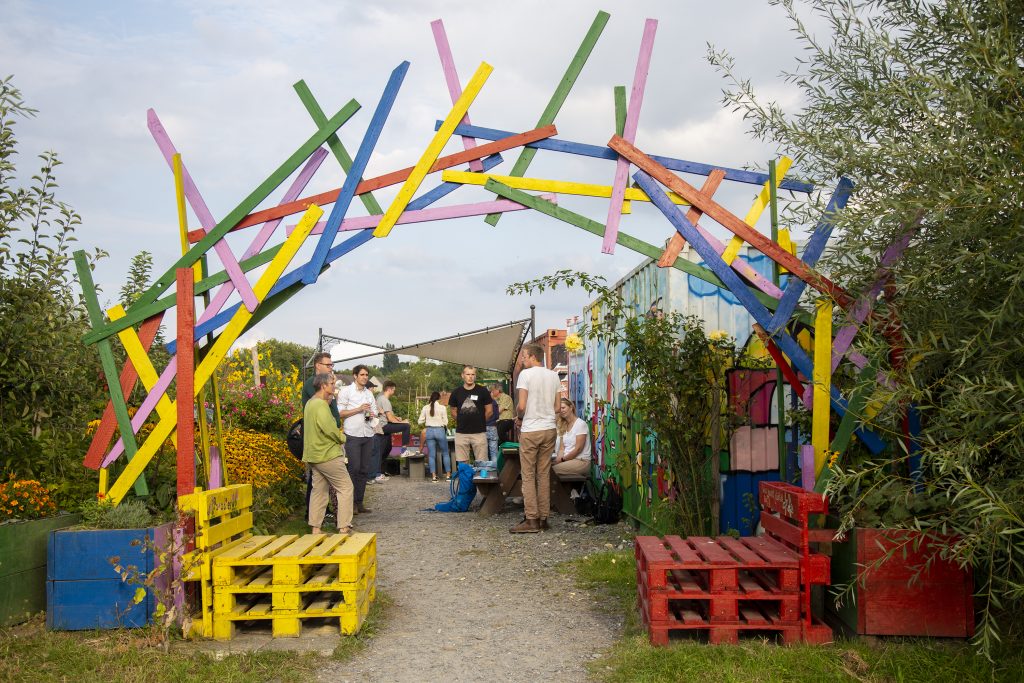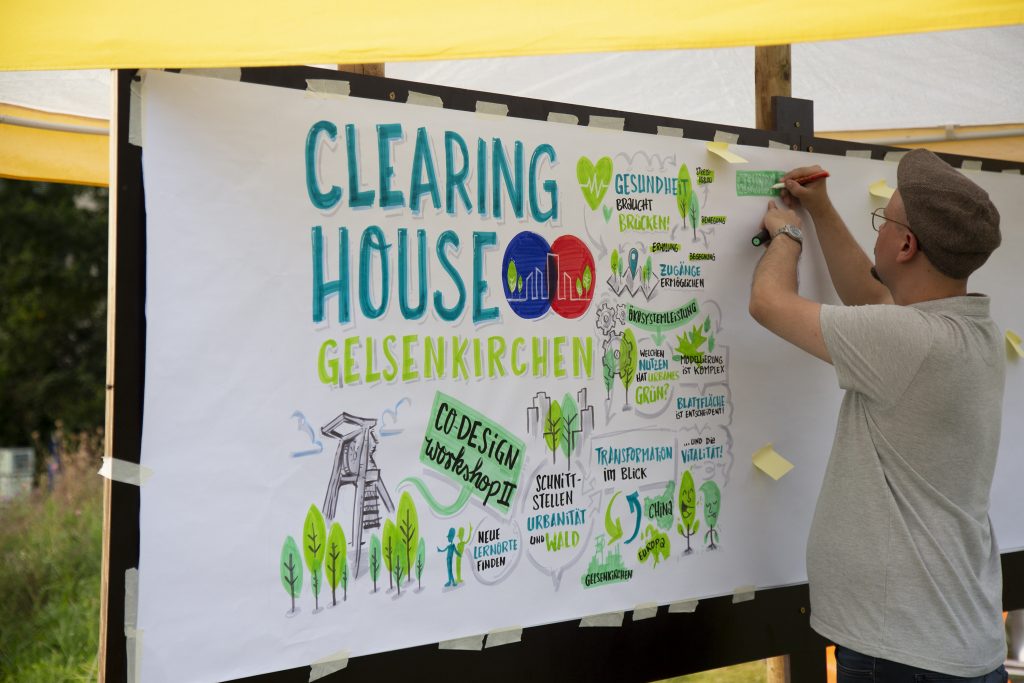
Using, protecting, shaping urban forests – and researching about them
Co-Design Workshop II, as part of the CLEARING HOUSE project at the Green Lab in Gelsenkirchen.
What is the importance of urban forests for our health, for the biodiversity in our cities and for the future of our densely populated region? What does the term participatory mapping mean? And what can we use the i-Tree software for?
These and other questions were discussed with 80 activists from the citizenry, politics, science and administration at the Green Lab Hugo, on September 9, 2021. The event included both expert presentations and a World Café. It was organized by the European Forest Institute, the Department of Environment of the City of Gelsenkirchen and the State Forest Enterprise Wald und Holz NRW (Regional Forestry Office of the Ruhr area) as part of the CLEARING HOUSE project.
The event started with three keynote speeches. After an official opening by moderator Michael Blaschke from Wald und Holz NRW and an introduction to the work of the European-Chinese research project CLEARING HOUSE by Prof. Dr. Georg Winkel, Dr. Thomas Claßen from the NRW Health State Center emphasized in his lecture how important forests are for human health. We can recover physically and mentally in nature, and forests and green spaces in the city enable gatherings and thus also improve our well-being. However, not all people have the same access to urban forests – and that needs to be addressed more, according to Dr. Claßen. In the second keynote presentation, Prof. Dr. Steffen Rust from the University of Applied Sciences and Arts in Hildesheim discussed the ecosystem services provided by urban forests in Gelsenkirchen. Then, his colleague Hannes Pillsticker presented the i-Tree service program, which evaluates tree-related ecosystem services with support, regulatory, production, and cultural functions. Although this sounds technical, it is actually very exciting in practice: Based on the tree cadastre of the city of Gelsenkirchen, structural data was recorded, ecosystem services were derived and the economic value was determined. It was made clear to the participants how many different functions forests fulfil and how they are of increasing importance – in times of climate change – for the functioning of the “urban habitat”.
The keynote speeches were followed by the World Café, consisting of nine thematic tables or discussion groups, to which the participants were assigned in each of the three rounds.
Following on from the keynote presentation by Dr. Thomas Claßen, the “Health” table discussed the “Impact of forest ecosystem services on the health of people in the city. From providing shade in heat islands, to providing recreational functions and purifying the air – as temperatures rise, we rely more and more on these ecosystem services.
Picking up on Prof. Dr. Stefan Rust’s keynote presentation, the “Green Infrastructure and Economy” thematic table looked at the results of the i-Tree service program. Possible consequences for the urban and landscape development of Gelsenkirchen were discussed and it was emphasized that “green” must be understood as infrastructure that is to be regarded with the same importance as, for example, urban mobility or supply infrastructure.
A third discussion group dealt with the “Regional Biodiversity Strategy”, including the case study of the Rheinelbe industrial forest, a biodiversity hotspot that was once a coal mine site. It became clear that especially in the Ruhr area, a densely built-up urban region in the midst of a transformation process, strategic planning is of great importance in order to further think about important approaches to green planning in the Ruhr metropolis.
At another table, participants discussed “Gelsenkirchen as a green-blue city of tomorrow.” In Gelsenkirchen, structural change is to be shaped sustainably – and in the process, forests, trees and waterways are not only to protect the climate, but also to be used to improve Gelsenkirchen’s image. Discussions also focused on common, powerful narratives for the future that can guide urban and regional development.
Street and park trees, but also trees in private gardens, not only beautify the cityscape through their diverse ecosystem services, but also have a positive impact on the climate in densely built-up urban areas. At the “Trees in the Neighbourhood” table, one of the topics discussed was the tree app of the city of Gelsenkirchen, which promotes and supports watering sponsorships for citizens. In addition, further possibilities for protecting Gelsenkirchen’s urban trees were discussed.
The topic “Citizen Science” got two thematic tables: One dealt with participatory mapping, which combines the tools of modern cartography with participatory methods. Here, citizens are invited to explore the forest and document it regarding climate-relevant, aesthetic and emotional aspects. Where do I feel comfortable? Where not so much? Who uses the forest? When, where and how? Each experience is recorded on a digital map. The other thematic table dealt with marteloscopes. These are small forest areas in which trees can be assessed based on their ecological and economic condition using a software developed for this purpose on tablets. Such a marteloscope is soon to be created in Gelsenkirchen, with the aim of promoting cooperation between science and urban society.

The panel on “Education for Sustainable Development” (ESD) discussed three projects currently being implemented in Gelsenkirchen: Future City 2030+, Learning City Gelsenkirchen and the Environmental Diploma. Urban forests play an important role for ESD structures and projects in Gelsenkirchen, as they can be used in many ways as an extracurricular learning space.
At the “Communication” table, ways to best communicate knowledge and research on urban forests were discussed. In particular, the focus was on how to engage different target groups – from citizens to politics and business – and relate sustainability issues to their own realities.
After the World Café rounds, the participants were able to enjoy a rich and sustainable buffet of freshly harvested vegetables and herbs from the Green Lab Hugo, which was lovingly prepared and served by the active gardeners of the Green Lab association.
The summary of the results was short because the event was speed up by a heavy thunderstorm during the closing credits. However, the entire workshop – like the 1st one in 2020 – was vividly documented by means of graphic recording.
All organizers are looking forward to the future of CLEARING HOUSE and invite you to get involved in the project and beyond – to shape Gelsenkirchen sustainably together.

Author: Anna Fischer
Photos: Rosa Castaneda
